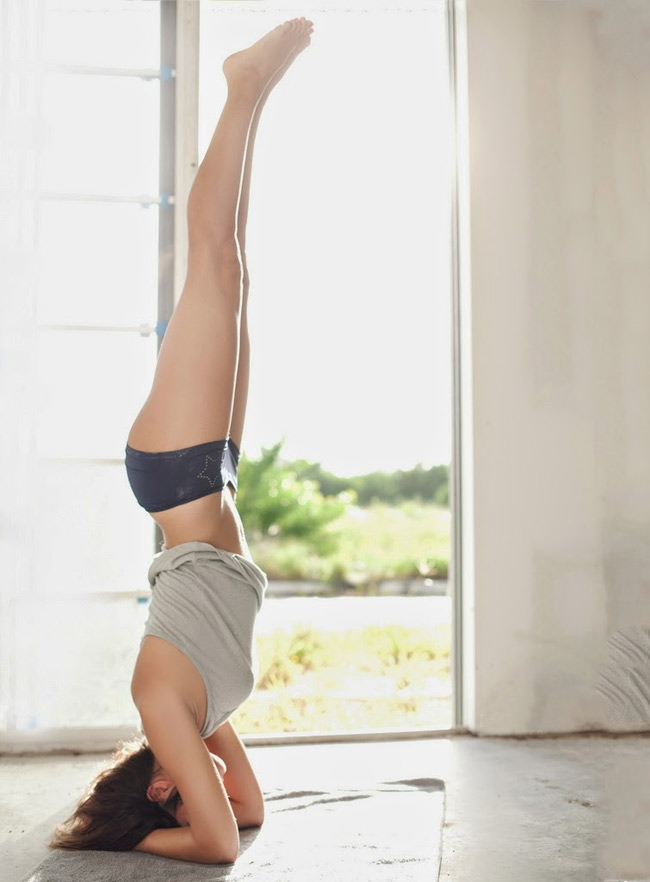
This asana is often referred to as the king of asanas because of its overall effect on individual’s physical and mental health. The pituitary gland is located inside the head and plays a pivotal role in the functioning of other glands that are a part of endocrine system. It is a pea-shaped endocrine gland in the brain responsible for metabolism, turning food into usable energy.
Benefits:
- This asana can increase the flow of blood to the brain.
- Improve memory and other functions of the cerebrum.
- It tones the Upper Body.
- Alleviates insomnia.
- This asana helps to build a strong core particularly if the practitioner lifts or lowers both legs at once to come into and out of the headstand.
- Headstands are recommended for irritable bowel syndrome and other digestive ailments, as they reorient the colon and intestines, encouraging bowel movement.
- Included in the physiological benefits are the drainage of blood and lymph which are held in reserve in the legs.
- This posture also helps relieve stress and mild depression. Headstand stimulates the pituitary gland — which is responsible for releasing endorphins, the body’s “happy” hormones.
- It stimulates blood flow to the face thereby increasing circulation to the skin of the cheeks and forehead
Instructions:
- Sit on soles. place knees on the ground.
- Frame finger lock with both hands.
- Making a triangle from finger-lock and elbows, place it on ground. The elbows and hands should be making an equilateral triangle on the ground. Keep the elbows directly underneath the shoulders.
- Bending forward, place middle of the head on the ground near finger-lock.
- Now straighten your legs.
- Slowly bring the legs near your body. Breathe in.
- Observe that the soles will automatically leave the ground by practice and thighs and knees will touch the abdomen.
- Now keeping the balance straighten your legs from thigh-joint, knees will remain folded. Gently and consciously push the shoulders away from the ears so that the neck is elongated avoiding any compression in the neck area. As a beginner, stay in this position with bent legs for as long as is comfortable and until you feel confident enough to straighten the legs.
- Now straighten the knees also and completely balance your body on head.
- While returning to the original position fold your knee first. Then fold your legs from thigh and let the thigh and knee touch your abdomen.
- Now slowly place the soles on the ground. Slowly raise your head also and sit on soles.
Note:
- Before you attempt this pose, ensure that your shoulder and triceps are strong enough to support you, and do not place most of your body weight on your head.
- While practicing Sirsasana, place that part of your head on the ground on which the spine can remain erect.
- Practice raising your legs with bent knees at first, and then once you have mastered the lift with bent knees, start trying to lift up with straight legs.
- Practice near a wall at first, so that you don’t fall back. Once you have achieved total control over the pose as you lift and find your balance, you can try the pose away from a wall.
- Stay in the asana for 5 – 8 breaths as a beginner, gradually increasing the length of breaths as confidence, strength and practice improves.
- Always consult a doctor before starting any exercise.
Contra-indications:
- Back injury
- Headache
- Heart condition
- High blood pressure
- Menstruation
- Neck injury
- Low blood pressure: Don’t start practice with this pose
- Glaucoma, detached retina, conjunctivitis
- Pregnancy
- Sirsasana is considered to be an intermediate to advanced pose. Do not perform this pose without sufficient prior experience or unless you have the supervision of an experienced teacher.
Other Asanas:
- Trikonasana
- Push Ups
- Bala-asana
- Ardha Sarvangasana
References
